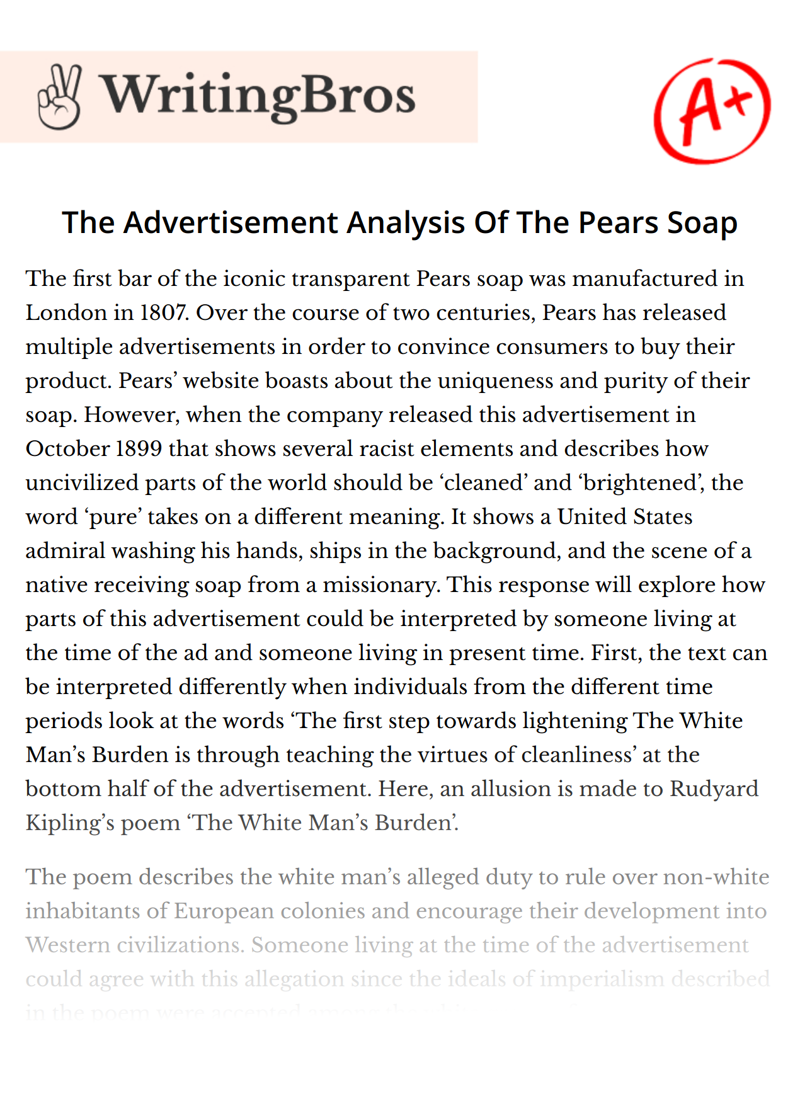The Advertisement Analysis Of The Pears Soap

The first bar of the iconic transparent Pears soap was manufactured in London in 1807. Over the course of two centuries, Pears has released multiple advertisements in order to convince consumers to buy their product. Pears’ website boasts about the uniqueness and purity of their soap. However, when the company released this advertisement in October 1899 that shows several racist elements and describes how uncivilized parts of the world should be ‘cleaned’ and ‘brightened’, the word ‘pure’ takes on a different meaning. It shows a United States admiral washing his hands, ships in the background, and the scene of a native receiving soap from a missionary. This response will explore how parts of this advertisement could be interpreted by someone living at the time of the ad and someone living in present time. First, the text can be interpreted differently when individuals from the different time periods look at the words ‘The first step towards lightening The White Man’s Burden is through teaching the virtues of cleanliness’ at the bottom half of the advertisement. Here, an allusion is made to Rudyard Kipling’s poem ‘The White Man’s Burden’.
The poem describes the white man’s alleged duty to rule over non-white inhabitants of European colonies and encourage their development into Western civilizations. Someone living at the time of the advertisement could agree with this allegation since the ideals of imperialism described in the poem were accepted among the white group of consumers that had the potential of purchasing the soap. The racism and misconduct like political, social and economic exploitation of the natives and their resources that came with territorial expansion did not even come close to being the moral issue that it is today. The phrase ‘the white man's burden’ was used as a justification for conquering new areas and bringing Western civilization to indigenous lands. Today, the words have become a euphemism for racism, colonialism and imperialism. The advertisement strengthens the stereotype of black skin as unappealing and unclean, while white is pure and superior. Since then, racism has come to be perceived as socially and morally wrong around the world. Therefore, someone living today who agrees that racism is unacceptable and is aware of the wrongdoings of imperialists and rejects them, would certainly deem the advertisement extremely inappropriate.
An individual living at the time of publication would not think of it that way, since they were unaware of the wrongdoings because racism was not rejected as it is today. Furthermore, someone living at the time of the ad would interpret it differently than someone living today when looking at the lowest part of the text, where it says: ‘Pears’ Soap is a potent factor in brightening the dark corners of the earth as civilization advances, while amongst the cultured of all nations it holds the highest place - it is the ideal toilet soap.’ Usually, we use soap to physically clean ourselves. In this part of the text it is clearly stated that the soap is a symbol of the civilization of the superior white British male. It is used by the man in the picture, Admiral George Dewey, who had taken on the ‘burden’ of bringing Western civilization to the ‘dark corners of the earth’.
A person living in 1899 who looked at these parts of the text would not be very surprised to see the degree of racism used. At the time, people of colour were considered to be inferior to white people, and people thought it was necessary to bring Western civilization to their part of the world. However, an individual who is alive today would look at the text and be critical about how the cultured West is said to be superior to the ‘dark corners of the earth’ and how it is necessary to ‘brighten’ them, since countries and their inhabitants are seen as equal by the majority of people living today. Last of all, the advertisement could be interpreted differently by people from different times when looking at the scene that is happening in the lower right corner of the image. A black man, presumably a native, is seen kneeling and begging for a bar of soap from a white missionary. As mentioned before, black people were believed to be lesser than white people at the time of the publishment of this advertisement. Therefore, an individual living at that time would think it was normal for a missionary to hand a bar of soap to a native in this manner. On the other hand, someone living in present time would view it as racist for a white person to let a black person kneel before them, and this person would disapprove of the advertisement.
To conclude, the text shows numerous aspects which would not be approved of by someone living in modern day society since racism and colonial imperialism are largely a thing of the past. At the time of the advertisement, ‘the white man’s burden’ was commonly thought to be a moral obligation to rule the ‘non-whites’ living on planet Earth, when it was in fact a justification for imperial conquest. Since people living today are aware of the wrongdoings of imperialists, they would deem the advertisement unacceptable. Individuals living at the time of the advertisement would not think of it that way since there was no moral issue like there is today. In today’s world, people are striving for equality for every human being, so the inequality shown in the text would be condemned. Someone living in 1899 would not disagree with the inequality shown because it was a construct of society that the majority agreed upon. Fortunately, our society has come a long way since then, and advertisements like the one from Pears remind us to keep looking forward.
Cite this Essay
To export a reference to this article please select a referencing style below

